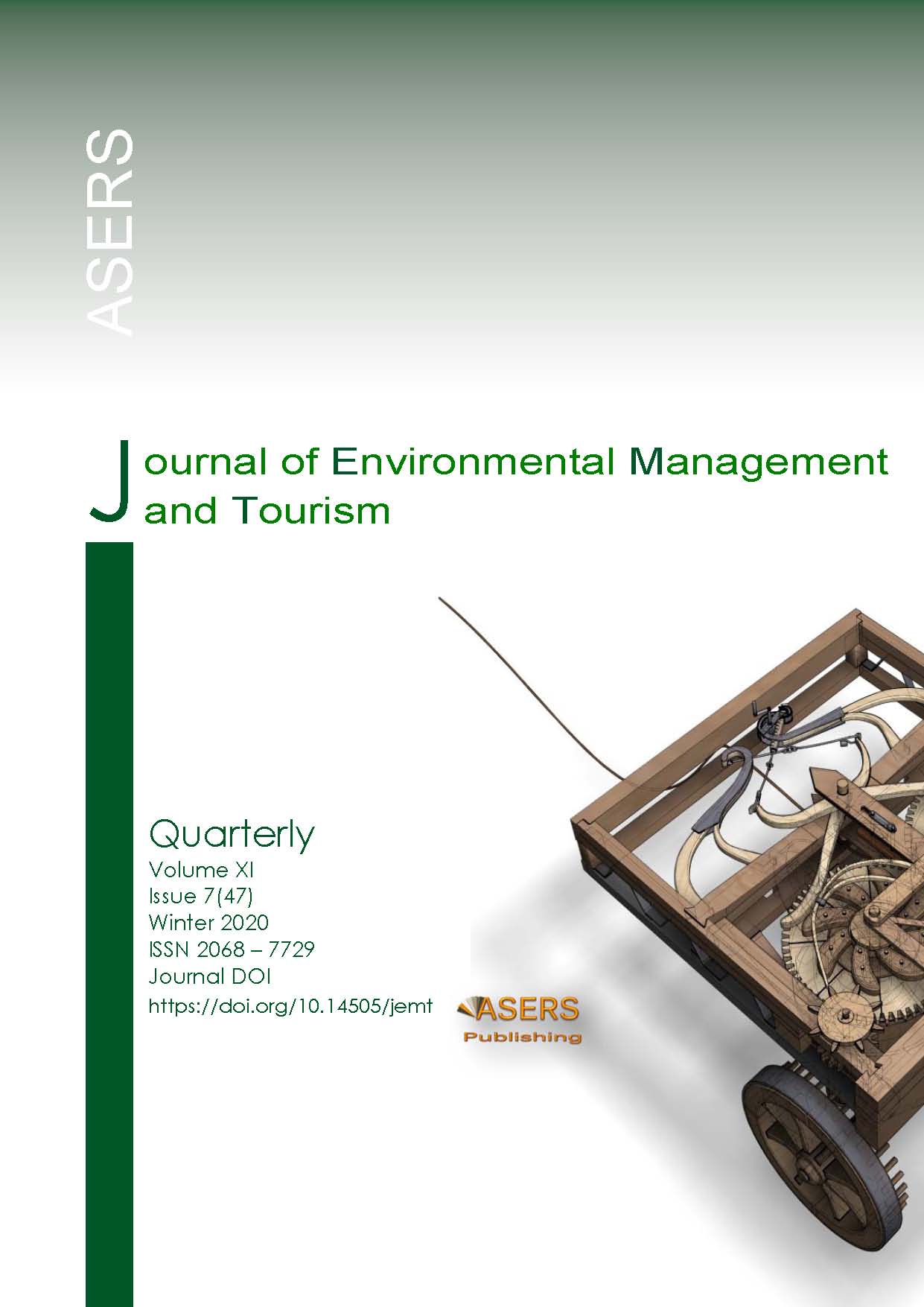Rehabilitation Tourism Opportunities in the Russian Federation for Recovering COVID-19 Patients
Abstract
The COVID-19 pandemic determined the necessity for prompt diagnostics and optimal routing of patients, followed by rehabilitation and secondary prevention, as domestic tourism intensifies. The epidemic increased the importance of digital systems for the tourism service market. Digitalization took leading positions in the tourism industry and made market participants adapt to these changes for optimizing their activities and increasing revenues. Further development of tourism in Russia, giving the ongoing pandemic, would require digital technologies such as multilanguage informational services overcoming language barriers, digital tourist cards, mobile apps introducing cultural and national landmarks online, web services for preparing tourist routes. Judging from scientific and practical experience, we can expect that medical, social, physical and psychological rehabilitation supervised by medical personnel will improve body functioning including heart, lungs, central nervous system as well as restore patients’ quality of life in general.
References
[2] Bhatia, R. T., et al. 2020. Exercise in the Severe Acute Respiratory Syndrome Coronavirus-2 (SARS-CoV-2) Era: A Question and Answer Session with the Experts Endorsed by the Section of Sports Cardiology & Exercise of the European Association of Preventive Cardiology (EAPC). European Journal of Preventive Cardiology, 27 (12): 1242–51. DOI: https://doi.org/10.1177/2047487320930596
[3] Choon-Huat Koh, G., and Hoenig, H. 2020. How Should the Rehabilitation Community Prepare for 2019-NCoV? Archives of Physical Medicine and Rehabilitation, 101 (6): 1068–71. DOI:https://doi.org/10.1016/j.apmr.2020.03.003
[4] Daily Electronic Newspaper of the Russian Union of Travel Industry. 2020. Rostourism Has Developed a Set of Measures to Save the Industry. Available at: https://ratanews.ru/news/news_16042020_3.stm/
[5] Del Rio, C., and Malani, P. N. 2020. 2019 Novel Coronavirus-Important Information for Clinicians. JAMA, 323 (11): 1039–40. DOI: https://doi.org/10.1001/jama.2020.1490
[6] Demeco, A., et al. 2020. Rehabilitation of Patients Post-COVID-19 Infection: A Literature Review. The Journal of International Medical Research, 48 (8): 300060520948382. DOI:https://doi.org/10.1177/0300060520948382
[7] Doremalen, N., et al. 2020. Aerosol and Surface Stability of SARS-CoV-2 as Compared with SARS-CoV-1. The New England Journal of Medicine, 382 (16): 1564–67. DOI: https://doi.org/10.1056/NEJMc2004973
[8] European Centre for Disease Prevention and Control. 2020. COVID-19 Situation Update Worldwide, as of 5 October 2020. Available at: https://www.ecdc.europa.eu/en/geographical-distribution-2019-ncov-cases
[9] Grech, V., Grech, P. and Fabri, S. 2020. A risk balancing act – Tourism competition using health leverage in the COVID-19 era. International Journal of Risk & Safety in Medicine, 31 (3): 121–30. DOI:https://doi.org/10.3233/JRS-200042
[10] Huang, C., et al. 2020. Clinical Features of Patients Infected with 2019 Novel Coronavirus in Wuhan, China. Lancet, 395 (10223): 497–506. DOI: https://doi.org/10.1016/S0140-6736(20)30183-5
[11] Ivanova, G. E., et al. 2020. Medical rehabilitation at a new coronavirus infection (COVID-19). Physical and rehabilitation medicine, medical rehabilitation, 2 (2): 140–89. DOI: https://doi.org/10.36425/rehab34231
[12] Ivanova, G. E., et al. 2020. Rehabilitation Care during the New COVID-19 Coronavirus Infection Epidemic at First, Second and Th Ird Medical Rehabilitation Phases. Physical and Rehabilitation Medicine, Medical Rehabilitation, 2 (2): 98–117. DOI: https://doi.org/10.36425/rehab34148
[13] Kampf, G., Todt, D. Pfaender, S. and Steinmann, E. 2020. Persistence of Coronaviruses on Inanimate Surfaces and Their Inactivation with Biocidal Agents. The Journal of Hospital Infection, 104 (3): 246–51. DOI:https://doi.org/10.1016/j.jhin.2020.01.022
[14] Khan, F., and Amatya, B. 2020. Medical Rehabilitation in Pandemics: Towards a New Perspective. Journal of Rehabilitation Medicine, 52 (4): jrm00043. DOI: https://doi.org/10.2340/16501977-2676
[15] Kiekens, C., et al. 2020. Rehabilitation and Respiratory Management in the Acute and Early Post-Acute Phase. ‘Instant Paper from the Field’ on Rehabilitation Answers to the COVID-19 Emergency. European Journal of Physical and Rehabilitation Medicine, 56 (3): 323–26. DOI: https://doi.org/10.23736/S1973-9087.20.06305-4
[16] Krasnokutskiy, P., et al. 2016. The Main Trends and Prospects of Development of International Tourism. International Journal of Economics and Financial Issues, 6 (8): 257–62.
[17] Lambert, I., et al. 2000. Interferential Therapy Machines as Possible Vehicles for Cross-Infection. The Journal of Hospital Infection, 44 (1): 59–64. DOI: https://doi.org/10.1053/jhin.1999.0647
[18] Liu, K., et al. 2020. Respiratory Rehabilitation in Elderly Patients with COVID-19: A Randomized Controlled Study. Complementary Therapies in Clinical Practice 39 (May): 101166. DOI:https://doi.org/10.1016/j.ctcp.2020.101166
[19] Machalkin, S. E., and Moreva, S. N. 2018. Analysis of the Dynamics of the Main Statistical Indicators of the Tourism Industry in Russia, 13 (104): 130–34. DOI: https://doi.org/10.20310/1819-8813-2018-13-104-130-134
[20] Ministry of Health of Russia. 2020. Temporary Guidelines for the Prevention, Diagnosis and Treatment of New Coronavirus Infection (COVID-19). Version 6 (04.28.2020). Available at: https://static-1.rosminzdrav.ru/system/attachments/attaches/000/050/122/original/28042020_МR_COVID-19_v6.pdf
[21] Mobin, M., et al. 2011. The Presence of Fungi on Contact Electrical Stimulation Electrodes and Ultrasound Transducers in Physiotherapy Clinics. Physiotherapy, 97 (4): 273–77. DOI:https://doi.org/10.1016/j.physio.2010.11.010
[22] Oesterle, M. E., et al. 2019. Are Ball Pits Located in Physical Therapy Clinical Settings a Source of Pathogenic Microorganisms? American Journal of Infection Control, 47 (4): 456–58. DOI:https://doi.org/10.1016/j.ajic.2018.09.031
[23] Ornell, F., Schuch, J. B. Sordi, A. O., and Kessler, F. H. P. 2020. Pandemic Fear’ and COVID-19: Mental Health Burden and Strategies. Revista Brasileira De Psiquiatria (Sao Paulo, Brazil: 1999), 42 (3): 232–35. DOI: https://doi.org/10.1590/1516-4446-2020-0008
[24] Spratt, H. G., et al. 2019. Topical Lotions Utilized in Outpatient Rehabilitation Clinics as a Potential Source of Bacterial Contamination. Physiotherapy Theory and Practice, 35 (2): 163–70. DOI:https://doi.org/10.1080/09593985.2018.1441935
[25] Stam, H. J., Stucki, G. and Bickenbach, J. 2020. Covid-19 and Post Intensive Care Syndrome: A Call for Action. Journal of Rehabilitation Medicine, 52 (4): jrm00044. DOI: https://doi.org/10.2340/16501977-2677
[26] Vlasova, I. 2020. An Unprecedented Crisis: How Many Hotels Will Lose. Gazeta.Ru. Available at: https://m.gazeta.ru/business/2020/04/30/13068283.shtml
[27] World Health Organization. 2020a. Coronavirus Disease (COVID-19) Pandemic. Available at: https://www.who.int/emergencies/diseases/novel-coronavirus-2019
[28] World Health Organization. 2020b. Support for Rehabilitation Self-Management after COVID-19- Related Illness. Available at: https://apps.who.int/iris/bitstream/handle/10665/333287/WHO-EURO-2020-855-40590-54571-eng.pdf
Copyright© 2025 The Author(s). Published by ASERS Publishing 2025. This is an open access article distributed under the terms of CC-BY 4.0 license.
